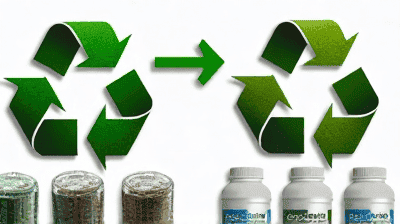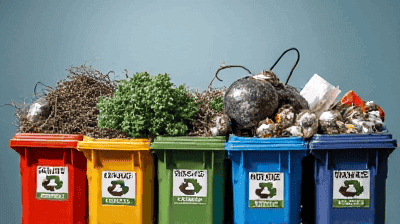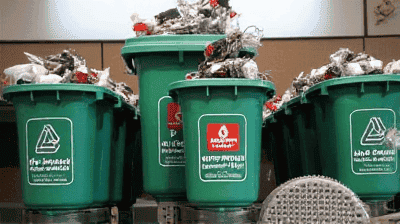
The escalating global pollution crisis calls for innovative solutions that go beyond conventional waste management practices. Traditional linear economic models, characterized by a 'take-make-dispose' approach, have contributed significantly to waste generation, resource depletion, and various forms of pollution. In contrast, the circular economy concept presents a systemic approach aimed at minimizing waste and making the most of available resources. By implementing circular economy principles, societies can reduce not only waste but also multiple types of pollution, including air, water, soil, and plastic pollution.
A circular economy is an economic system aimed at eliminating waste and the continual use of resources. It is founded on the following principles:
Design for Longevity: Products are designed to last longer, be easily maintained, repaired, and reused, thereby reducing the need for new resources.
Resource Recovery: End-of-life products are reused, refurbished, or recycled to extract resources, minimizing the consumption of virgin materials.
Systems Thinking: The interconnections between various components of the economy are understood, leading to more efficient resource management and pollution reduction.
Sustainable Business Models: Companies adopt business models that focus on providing services rather than selling products, encouraging efficiency and sustainability.
The transition to a circular economy offers numerous benefits:
Waste Reduction: By emphasizing resource recovery and reuse, a circular economy significantly reduces the amount of waste sent to landfills.
Pollution Control: Reduced waste generation directly translates to a decrease in pollution across various environmental media, including air and water.
Resource Conservation: Circular economies promote the sustainable use of resources, decreasing the reliance on finite materials and contributing to ecological balance.
Economic Growth: Embracing a circular economy can stimulate innovation, create jobs, and boost economic growth while enhancing environmental sustainability.
Climate Change Mitigation: By reducing waste and pollution, a circular economy can also lower greenhouse gas emissions, mitigating climate change impacts.

Air Pollution: Traditional manufacturing processes often lead to significant air emissions. By minimizing resource extraction, production processes become more efficient, leading to reduced emissions of greenhouse gases and other air pollutants.
Water Pollution: Industrial processes and agricultural runoff contribute to water pollution. Circular economy practices such as reducing excess chemical use and treating wastewater can greatly improve water quality.
Soil Pollution: Improper waste disposal and the use of synthetic materials can contaminate soil. By emphasizing waste reduction and promoting the recycling of materials, the circular economy can help restore soil health.
Plastic Pollution: The growing problem of plastic pollution can be addressed by adopting circular practices that encourage the use of biodegradable materials and the recycling of plastics.
The circular economy achieves waste reduction and pollution control through several key mechanisms:
Product Design and Innovation: Designing products with sustainability in mind encourages the use of eco-friendly materials and enhances recyclability.
Extended Producer Responsibility: Manufacturers are held accountable for the entire lifecycle of their products, including post-consumer waste management.
Consumer Education and Engagement: By informing consumers about sustainable choices and the importance of reducing waste, individuals can contribute to circular economy goals.
Collaboration Across Industries: Companies can collaborate to share resources and reduce waste through industrial symbiosis, where the waste of one industry becomes the input for another.
Sustainable product design, or eco-design, focuses on creating products that minimize environmental impacts throughout their lifecycle. Key strategies include:
Modular Design: Creating products that can be easily disassembled allows for easier repair and upgrading, thus prolonging their lifespan.
Material Selection: Using sustainable materials that are recyclable, biodegradable, or derived from renewable sources reduces environmental harm.
Energy Efficiency: Designing products that consume less energy during use can lead to lower emissions and decreased resource consumption.
Conducting a life cycle assessment (LCA) helps companies evaluate the environmental impact of their products from production to disposal. An LCA can guide design decisions and highlight opportunities for reducing waste and pollution.
Implementing efficient waste collection and sorting systems increases the amount of waste that can be recycled. Strategies include:
Single-Stream Recycling: Simplifying recycling processes by allowing all recyclables to be placed in a single bin can enhance participation rates.
Advanced Sorting Technologies: Investing in technologies such as artificial intelligence and robotics can improve the accuracy of waste sorting, increasing recycling rates.
Developing closed-loop recycling systems, where materials are recycled back into the same product, helps reduce raw material consumption and waste. This practice can minimize resource extraction and lower emissions related to production.
Encouraging local repair initiatives can extend the life of products while fostering community engagement. Repair cafés provide spaces where individuals can learn to fix broken items instead of discarding them.
Promoting second-hand shopping and online platforms for re-selling used items can significantly reduce waste and promote circular consumption patterns.
EPR programs require manufacturers to take responsibility for the entire lifecycle of their products, including end-of-life management. Key components include:
Take-Back Programs: Companies can establish take-back programs that allow consumers to return used products for proper recycling or disposal.
Financial Incentives: Offering incentives to manufacturers who adopt sustainable practices encourages adherence to EPR initiatives and promotes waste reduction.
Switching from a product ownership model to a product-as-a-service model encourages sustainability by promoting the sharing and leasing of products. This approach ensures products are used to their maximum potential while reducing waste.
Collaboration between different industries can lead to the exchange of resources, where the waste of one company becomes the raw material for another. This process reduces overall waste and maximizes resource efficiency.

Unilever is an exemplary model of circular economy practices. The company has committed to designing all of its packaging to be recyclable, reusable, or compostable by 2025. Unilever's Sustainable Living Plan aims to halve its environmental footprint while increasing positive social impact, demonstrating the company's commitment to waste reduction and pollution control.
IKEA has embraced a circular economy by committing to becoming climate positive by 2030. This involves designing products for longevity, promoting sustainable materials, and establishing take-back programs for used furniture. Through these initiatives, IKEA aims to minimize waste and promote resource efficiency.
Patagonia has pioneered an approach to sustainability that includes repair services, second-hand sales, and environmentally conscious product design. The company's Worn Wear program encourages customers to repair and recycle old garments, promoting reduced textile waste and environmental stewardship.
The Ellen MacArthur Foundation is at the forefront of promoting circular economy principles globally. By collaborating with various industries, governments, and academic institutions, the foundation drives systemic change toward a circular economy and provides resources for businesses to implement sustainable practices.
While the benefits of a circular economy are substantial, transitioning from a linear to a circular model presents challenges:
Changing consumer behaviors and mindsets is crucial for the success of circular economy initiatives. Education and awareness campaigns are essential to foster a culture of sustainability and responsibility.
The initial costs of implementing circular economy strategies can be high, and some businesses may hesitate to invest without immediate financial returns. Long-term economic models that demonstrate savings through waste reduction and resource efficiency can help mitigate these concerns.
Existing regulations often favor linear models of production and consumption. Policymakers must develop supportive legal and regulatory frameworks that promote circular practices and dismantle barriers to entry.
Implementing circular economy practices requires collaboration among various stakeholders, including governments, businesses, and communities. Facilitating effective communication and coordination can be challenging but is essential for success.

Governments can implement financial incentives and subsidies for businesses that adopt circular economy practices, reducing the economic barriers to entry.
Creating policies that establish standardized definitions and guidelines for circular economy practices can unify efforts and clarify expectations for businesses and consumers.
Engaging communities through awareness campaigns can promote understanding and support for circular economy initiatives, encouraging public participation.
Governments can partner with industry leaders to develop best practices, share knowledge, and establish benchmarks for circular economy efforts.
The circular economy presents a transformative opportunity to reduce waste and control multiple pollution types, promoting sustainability and environmental preservation. By embracing innovative practices such as sustainable product design, enhanced recycling systems, repair and reuse initiatives, and collaboration among stakeholders, societies can significantly mitigate the environmental impacts of waste.
As the world faces an increasing array of environmental challenges, adopting circular economy principles is more critical than ever. By working together to implement these strategies, we can create a healthier, more sustainable future for generations to come.